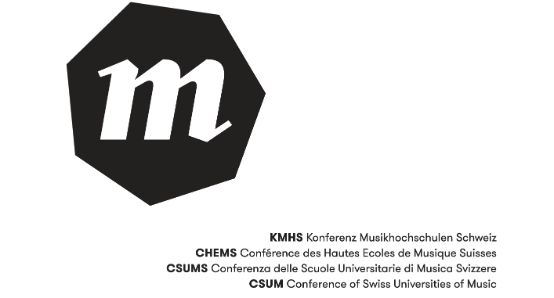Digitalizzazione e istruzione musicale superiore

Dopo i grandi adattamenti imposti dalla crisi del COVID-19, le Università svizzere di musica hanno continuato i loro sforzi per integrare la digitalizzazione nelle loro attività.
Antoine Gilliéron - Now that the ashes of confinement are gradually falling away, stakeholders in higher music education in Switzerland can take a deeper look at the essential steps involved in implementing digitization processes that are both efficient and facilitating for everyone, as well as respectful of both people and the environment.
For successful digitization, a university of the arts must undertake a whole series of steps, from maturity analysis to the launch of a digital strategy.
Thus, an art school wishing to take a digital turn would have to make changes in its relationship (digital or otherwise) with students and staff, in the use of the data it has or would benefit from collecting systematically, and in the automation of administrative processes. Nevertheless, it is imperative that the company embarks on this digitalization process using the resources at its disposal.
An organization's digital progress (i.e. its degree of digitization) is measured by taking into account its technological practices combined with its motivation to enrich and deploy this know-how. Consequently, the thinking behind a digitization approach by a music training institution should be based on the following elements:
Student experience: the academic institution has implemented the possibility of interacting with students, in order to gather data useful for adjusting study plans and communication;
- Pedagogical innovation: the organization has adapted its teaching and training delivery methods to digital innovations;
- Strategy: the educational institution prioritizes the development of digital projects and can clearly define the skills it needs to guarantee the school's success and influence;
- Organization: the resources available are sufficient and the administration is flexible enough to react quickly to technological developments;
- Digitization of processes: the training entity has integrated digital channels for communication, processes and services;
- Collaborative working: employees collaborate via digital platforms and in-house experts are responsible for managing digital issues;
- Information technology: The in-house IT department is able to integrate new products and services quickly and efficiently;
- Culture and expertise: digital expertise plays a central role in the school's development, and our staff are experts in digital products and services;
- Change management : Digital transformation follows a strategic plan, and managerial objectives are clearly defined.
Since the first use of technology in music and its learning, which Beethoven achieved by dedicating his work Wellington's victory from the inventor of the metronome, Johann Nepomuk Maelzel, to the present day, where the hybridization of face-to-face and digital practices reinforces the transmission of musical knowledge, the use of new technical means to serve the pedagogical act in music has a great tradition. Digital technology is a tool that can not only enhance student learning, but also improve the quality of teaching. With this aim of digital teaching and learning, the main measure is to increase the hybridization of practices, meaning that teachers can integrate technology into their transmission of knowledge, upstream, downstream or during lessons.
However, the sine qua non The key to this increase in digital teaching lies in the ability of digital integration to add pedagogical value and change the didactic logic of teaching that is sometimes too prescriptive and not sufficiently learner-centric. In other words, technology serves pedagogy, or the pedagogue's art takes precedence over the means he or she uses to express it.
Consequently, the founding principles for integrating new technologies into music teaching are as follows:
- Technology is not an end in itself;
- The use of this technology meets a need;
- Digital technology is only of interest if it improves pedagogy.
For a (digital) future that makes sense
Throughout its rich history, music has never ceased to question the contemporary. At the beginning of this century, opened with a bang by the health crisis of 2020 and the devastating fire of 1914, the teaching of music is questioning its interactions with the digital world, which today represents a fundamental challenge from a political and economic, environmental, societal and scientific point of view.
Distance learning, global networks, augmented reality, artificial intelligence, ICT, metadata and other digital learning environments are all examples of technological developments that are transforming the world of art, thought and research. Now at the heart of the daily lives of students, teachers and their audiences, these advances in the human mind are transforming ways of teaching and learning, opening up new prospects for academic acti-vities, offering powerful utilities for producing and sharing knowledge, while fostering the emergence of transversalities with other art forms and reinforcing the democratization of culture.
Digital technology is also driving change and innovation in higher education's administrative and technical departments, which are seeing their processes dematerialize and become more efficient in many respects. In this way, digital technology can help the higher music education sector to evolve in terms of the training, services and research it offers, as well as the new professions it helps to create, with the aim of generating value for society. The civilizational avant-garde that artists have always formed is thus making its contribution to the common edifice, helping to build a digital universe that is ever more ecological and meaningful, where poetry, enlightenment and humanism can blend harmoniously within the digital transformation underway in academia and society, in the service of music and its intergenerational transmission.
Digitalisierung-und-Musikstudium
Zusammenfassung: PS - Nach den grossen Anpassungen, die zur Bewältigung der Covid-Krise nötig waren, schreiten die schweizerischen Musikhochschulen nun bei der Digitalisierung weiter voran. Damit diese erfolgreich verläuft, sind von der Analyse bis zur Implementierung einer Strategie viele Schritte notwendig. Dabei müssen die Formen des Kontakts mit Studierenden und Mitarbeitenden einbezogen werden, die Nutzung vorhandener oder zu erhebender Daten und die Verwaltungsabläufe. Die Digitalisierung muss zwingend von den bestehenden Ressourcen ausgehen.
Die Informatik unterstützt das studentische Lernen und erhöht die Unterrichtsqualität. Der wichtigste Schritt besteht also darin, öfter hybride Praktiken in der Wissensvermittlung einzusetzen, sei dies vor, nach oder während dem Unterricht. Damit das wirklich einen Mehrwert bringt, müssen die manchmal allzu engen didaktischen Vorgaben überdacht und stärker auf die Lernenden ausgerichtet werden. Daraus leiten sich die grundlegenden Vorgaben für die Integration neuer Techniken in der Musikausbildung ab: Technologie ist kein Selbstzweck. - Der Einsatz einer Technologie entspricht einem Bedürfnis. - Digitalisierung ist nur von Interesse, wenn sie die Pädagogik weiterbringt.
Fernunterricht, Netzwerke, Augmented Reality, KI, IKT, Metadaten und andere digitale Lernumgebungen verändern Kunst, Denken und Forschung. Im Alltag von Studierenden, Dozierenden und ihrem Publikum verändern sie die Art, wie unterrichtet, gelernt und geforscht wird.
Auch die administrativen und technischen Dienste sind von der Digitalisierung betroffen. Dadurch steigt der Stellenwert, den die Hochschulen im Hinblick auf ihre Ausbildungs-, Dienstleistungs- und Forschungsangebote einnehmen. Sie schaffen neue Berufe und damit einen Mehrwert für die Gesellschaft.
Strengthening-digitalMusic-in-Society
Strengthening Music in Society provides musicians, music students and those working in the music education sector with resources and tools. The aim is to help Higher Music Education Institutions (HMEI) to strengthen the social relevance of music education and improve access to music education, but also strengthen the impact of music, art, culture and cultural education on society.
The material published are outcomes of the project Strengthening Music in Society conductec by the Association Européenne des Conservatoires, Académies de Musique et Musikhochschulen and supported by the Creative Europe Programme.
The material provided by following the QR-code is divided into different themes and can be used for different purposes:
- to raise the social responsibility of artists and to advocate for the arts at different government levels
- to open the HMEIs' educational offer towards more diversity
- to embed entrepreneurial skills in the education of the music students for their future as professional musicians
- to help students and teachers internationalise their careers
- to explore and discuss new Learning and Teaching models
- to increase the quality of early childhood music education, and thus extend the audience of tomorrow
- Last but not least, to encourage the use of digital media and digital-based learning tools in music teaching
For more information:








